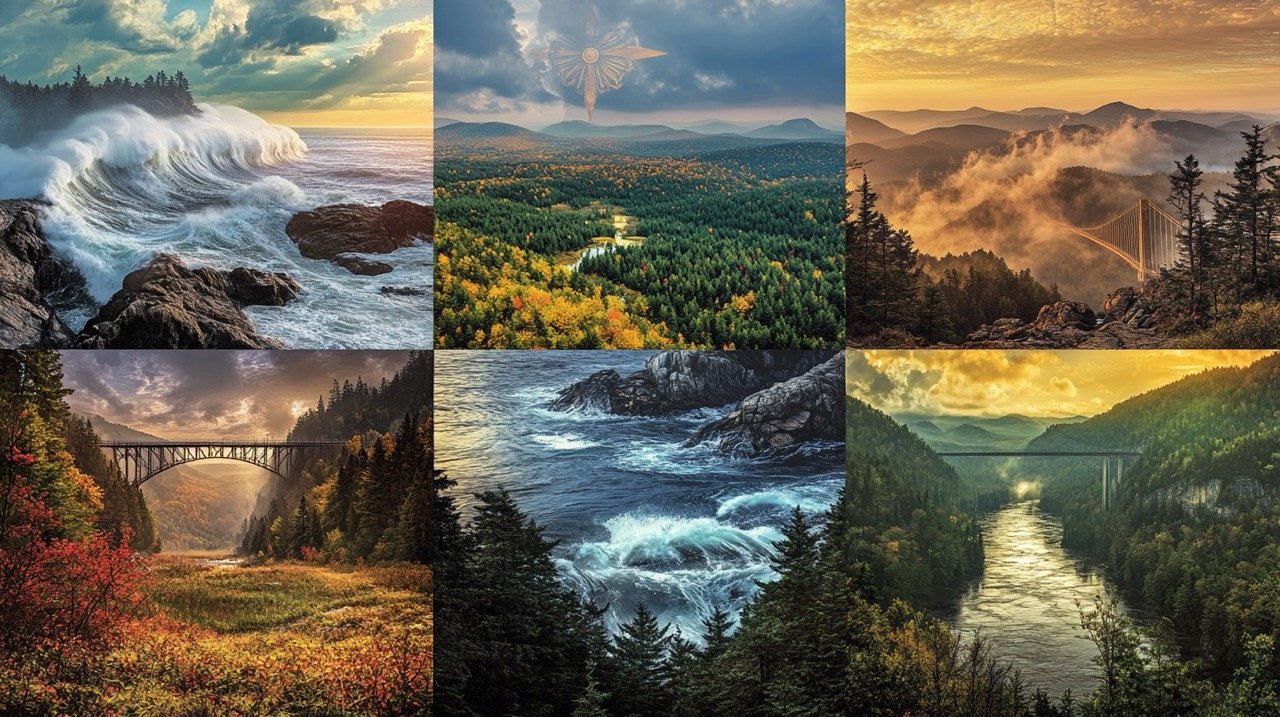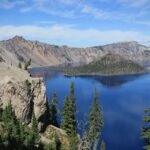Introduction to East Coast National Parks

From the rugged coastlines of Maine to the subtropical wetlands of Florida, the East Coast of the United States boasts an impressive array of national parks that showcase the region’s diverse landscapes, rich ecosystems, and fascinating history. These natural treasures offer visitors a chance to explore some of the most stunning scenery and unique habitats in North America, all while providing crucial protection for countless plant and animal species.
In this comprehensive guide, we’ll take you on a journey through 10 of the most captivating national parks along the Eastern Seaboard. Whether you’re an avid hiker, a wildlife enthusiast, or simply seeking a peaceful retreat into nature, these parks have something extraordinary to offer every visitor.
Why Explore East Coast National Parks?
The national parks of the East Coast present a remarkable variety of experiences:
- Ancient mountain ranges carved by millennia of erosion
- Pristine coastal habitats teeming with marine life
- Vast wetlands home to unique and endangered species
- Dense forests showcasing the changing seasons in spectacular fashion
- Historic sites that tell the story of America’s natural and cultural heritage
National parks not only provide unparalleled recreational opportunities but also play a vital role in conservation efforts. They preserve essential habitats, protect endangered species, and maintain the delicate balance of ecosystems that are increasingly threatened by climate change and human activity.
What to Expect in This Guide
In the following sections, we’ll delve into each of these 10 East Coast national parks:
- Acadia National Park, Maine
- Shenandoah National Park, Virginia
- Great Smoky Mountains National Park, Tennessee/North Carolina
- Everglades National Park, Florida
- Biscayne National Park, Florida
- Congaree National Park, South Carolina
- Dry Tortugas National Park, Florida
- Cape Hatteras National Seashore, North Carolina
- New River Gorge National Park and Preserve, West Virginia
- Cuyahoga Valley National Park, Ohio
For each park, we’ll provide:
- An overview of its unique features and natural wonders
- Must-see attractions and hidden gems
- Best activities and experiences for visitors of all interests
- Wildlife and nature highlights
- Practical information for planning your visit
We’ll also cover the best times to visit these parks, offer tips for planning your East Coast national park adventure, and provide information on ongoing conservation efforts. Whether you’re planning a family vacation, a solo adventure, or a romantic getaway, this guide will help you make the most of your East Coast national park experience.
So, lace up your hiking boots, pack your sense of adventure, and join us as we explore the natural wonders waiting to be discovered along the East Coast. Let’s embark on a journey through some of America’s most treasured landscapes!
Overview of East Coast National Parks

The East Coast of the United States is home to a diverse array of national parks, each offering unique landscapes, ecosystems, and experiences. From the rocky shores of Maine to the tropical waters of Florida, these parks showcase the incredible natural diversity of the Eastern Seaboard.
Geographical Diversity
East Coast national parks span a wide range of geographical features:
- Coastal Areas: Parks like Acadia and Cape Hatteras showcase dramatic coastlines, sandy beaches, and marine ecosystems.
- Mountain Ranges: The Appalachian Mountains are featured in parks such as Shenandoah and Great Smoky Mountains.
- Wetlands and Swamps: The Everglades and Congaree protect vital wetland habitats.
- Islands: Dry Tortugas and Biscayne offer unique island ecosystems in the Florida Keys.
- Rivers and Valleys: New River Gorge and Cuyahoga Valley preserve important riverine environments.
Ecological Importance
These parks play a crucial role in preserving biodiversity and protecting endangered species. They serve as refuges for wildlife and maintain ecological balance in increasingly urbanized areas.
They preserve essential habitats, protect endangered species, and maintain the delicate balance of ecosystems.
Historical Significance
Many East Coast national parks also preserve sites of historical and cultural importance, offering visitors a chance to connect with America’s past while enjoying its natural beauty.
Visitor Statistics
To give you an idea of the popularity of these parks, here’s a table showing the approximate annual visitor numbers for each of the parks we’ll be discussing:
| Park Name | State(s) | Approx. Annual Visitors |
|---|---|---|
| Great Smoky Mountains | TN/NC | 14 million |
| Acadia | ME | 4 million |
| Shenandoah | VA | 1.4 million |
| Everglades | FL | 1 million |
| Cuyahoga Valley | OH | 2.2 million |
| New River Gorge | WV | 1.6 million |
| Biscayne | FL | 700,000 |
| Congaree | SC | 160,000 |
| Dry Tortugas | FL | 80,000 |
| Cape Hatteras | NC | 3 million |
Conservation Challenges
East Coast national parks face various conservation challenges:
- Climate Change: Rising sea levels, changing weather patterns, and increasing temperatures affect ecosystems and wildlife.
- Urbanization: Encroaching development threatens park boundaries and wildlife corridors.
- Invasive Species: Non-native plants and animals disrupt local ecosystems.
- Overuse: Popular parks struggle to balance visitor access with resource protection.
These parks play a crucial role in preserving biodiversity and protecting endangered species.
Economic Impact
National parks on the East Coast contribute significantly to local and regional economies through tourism, creating jobs, and supporting local businesses.
In the following sections, we’ll explore each of these parks in detail, highlighting their unique features, must-see attractions, and tips for making the most of your visit. Whether you’re planning a road trip through multiple parks or focusing on one destination, the East Coast’s national parks offer endless opportunities for adventure, learning, and connecting with nature.
Acadia National Park: Maine’s Coastal Gem

Nestled along the rugged coast of Maine, Acadia National Park stands as a testament to the raw beauty of the northeastern United States. As one of the most visited national parks on the East Coast, Acadia offers a unique blend of rocky shorelines, dense forests, and granite-domed mountains.
Key Features
- Diverse Landscapes: From rocky beaches to lush woodlands and crystal-clear lakes
- Cadillac Mountain: The highest point on the U.S. Atlantic coast
- Historic Carriage Roads: 45 miles of rustic carriage roads perfect for biking and walking
- Scenic Park Loop Road: A 27-mile road showcasing the park’s highlights
Must-See Attractions
- Thunder Hole: A small inlet where waves crash with thunderous sounds
- Jordan Pond: A glacier-formed lake with crystal-clear waters
- Otter Cliff: One of the highest Atlantic coastal headlands north of Rio de Janeiro
- Bass Harbor Head Lighthouse: An iconic lighthouse perched on rocky cliffs
Best Activities
- Hiking: Over 120 miles of trails ranging from easy walks to challenging climbs
- Biking: Explore the historic carriage roads
- Scenic Drives: Take in the views along Park Loop Road
- Stargazing: Acadia is known for its dark skies, perfect for astronomy enthusiasts
- Wildlife Watching: Spot seabirds, whales (seasonally), and land mammals
Wildlife Highlights
- Peregrine falcons
- Harbor seals
- White-tailed deer
- Various seabird species
Practical Information
| Category | Details |
|---|---|
| Best Time to Visit | June to October |
| Entrance Fee | $30 per vehicle (valid for 7 days) |
| Nearest Airport | Bangor International Airport (BGR) |
| Accommodation | Campgrounds within the park, hotels and B&Bs in nearby towns |
Hiking Trails Table
| Trail Name | Difficulty | Length | Estimated Time |
|---|---|---|---|
| Ocean Path | Easy | 2.2 miles | 1-2 hours |
| Beehive Loop | Strenuous | 1.4 miles | 1.5-2 hours |
| Jordan Pond Path | Easy | 3.3 miles | 2-2.5 hours |
| Cadillac Summit Loop | Easy | 0.3 miles | 15-30 minutes |
| Precipice Trail | Extremely Strenuous | 2.5 miles | 2-3 hours |
Conservation Efforts
Acadia faces several conservation challenges:
- Overcrowding: Implementing reservation systems for popular areas
- Climate Change: Monitoring and adapting to changing ecosystems
- Invasive Species: Ongoing efforts to control non-native plants and insects
Local Tip
Visit during fall for spectacular foliage colors and fewer crowds. The crisp air and vibrant landscapes make for an unforgettable experience.
Acadia National Park offers a perfect blend of natural beauty, outdoor recreation, and rich history. Whether you’re seeking adventure on its granite cliffs or tranquility along its forested trails, Acadia provides a quintessential New England national park experience that will leave you in awe of the East Coast’s natural wonders.
Shenandoah National Park: Virginia’s Mountain Paradise

Stretching along the Blue Ridge Mountains in Virginia, Shenandoah National Park offers a serene escape into the heart of Appalachia. Known for its stunning vistas, diverse wildlife, and the famous Skyline Drive, Shenandoah provides visitors with a perfect blend of natural beauty and outdoor adventure.
Key Features
- Skyline Drive: A 105-mile scenic road running the entire length of the park
- Blue Ridge Mountains: Part of the Appalachian Mountain range
- Shenandoah Valley: Offers breathtaking views from numerous overlooks
- Diverse Ecosystems: From hardwood forests to rocky peaks
Must-See Attractions
- Old Rag Mountain: A challenging hike with spectacular 360-degree views
- Dark Hollow Falls: One of the park’s most picturesque waterfalls
- Hawksbill Summit: The highest point in the park at 4,051 feet
- Rapidan Camp: President Herbert Hoover’s former summer retreat
Best Activities
- Hiking: Over 500 miles of trails, including a section of the Appalachian Trail
- Scenic Driving: Explore Skyline Drive’s 75 scenic overlooks
- Wildlife Viewing: Spot deer, black bears, and over 200 bird species
- Rock Climbing: Popular at locations like Old Rag and Little Stony Man
- Fishing: Try your luck in over 70 mountain streams
Wildlife Highlights
- Black bears
- White-tailed deer
- Wild turkeys
- Various songbird species
Practical Information
| Category | Details |
|---|---|
| Best Time to Visit | Late spring and fall for mild weather and stunning foliage |
| Entrance Fee | $30 per vehicle (valid for 7 days) |
| Nearest Airport | Charlottesville Albemarle Airport (CHO) or Washington Dulles International Airport (IAD) |
| Accommodation | Lodges within the park, campgrounds, and nearby hotels |
Hiking Trails Table
| Trail Name | Difficulty | Length | Estimated Time |
|---|---|---|---|
| Dark Hollow Falls | Moderate | 1.4 miles | 1-1.5 hours |
| Old Rag Circuit | Very Strenuous | 9.2 miles | 7-8 hours |
| Stony Man Trail | Easy | 1.6 miles | 1-1.5 hours |
| White Oak Canyon | Strenuous | 8.2 miles | 5-6 hours |
| Bearfence Mountain | Moderate | 1 mile | 1 hour |
Conservation Efforts
Shenandoah faces several conservation challenges:
- Air Quality: Monitoring and addressing air pollution from nearby urban areas
- Invasive Species: Ongoing efforts to control non-native plants and insects
- Climate Change: Studying and adapting to shifting ecosystems and wildlife patterns
Local Tip
Visit during fall for spectacular foliage colors. The park’s hardwood forests transform into a vibrant palette of reds, oranges, and yellows, making it one of the most picturesque times to experience Shenandoah.
Comparison with Other Parks
While Shenandoah shares some similarities with parks like Great Smoky Mountains National Park, it offers a unique experience with its iconic Skyline Drive and more accessible mountain vistas. The park’s proximity to Washington D.C. also makes it a popular getaway for urban dwellers seeking nature.
Shenandoah National Park offers a perfect escape into the beauty of the Appalachian Mountains. Whether you’re driving along Skyline Drive, hiking to breathtaking vistas, or simply enjoying the tranquility of the forest, Shenandoah provides a quintessential Blue Ridge Mountains experience that showcases the natural splendor of Virginia’s highlands.
Great Smoky Mountains National Park: A Misty Mountain Haven

Straddling the border between Tennessee and North Carolina, Great Smoky Mountains National Park is the most visited national park in the United States. Known for its diverse plant and animal life, ancient mountains, and remnants of Southern Appalachian mountain culture, the park offers a unique blend of natural wonders and rich history.
Key Features
- Diverse Ecosystems: From lush forests to high mountain tundra
- Appalachian Trail: 71 miles of the famous trail runs through the park
- Historic Structures: Over 90 historic buildings preserved
- Cades Cove: An 11-mile loop road showcasing wildlife and historic buildings
Must-See Attractions
- Clingmans Dome: The highest point in the park with a 360-degree viewing tower
- Newfound Gap: The lowest drivable pass through the park
- Roaring Fork Motor Nature Trail: A scenic driving loop with waterfalls and historic buildings
- Cataloochee Valley: Known for its elk herd and preserved buildings
Best Activities
- Hiking: Over 800 miles of trails for all skill levels
- Scenic Drives: Numerous scenic roads offering beautiful vistas
- Wildlife Viewing: Spot black bears, elk, and over 200 bird species
- Fishing: 2,900 miles of streams, many for wild trout
- Horseback Riding: Several stables offer guided rides
Wildlife Highlights
- Black bears (approximately 1,500 in the park)
- Elk (reintroduced in 2001)
- White-tailed deer
- Over 200 bird species
Practical Information
| Category | Details |
|---|---|
| Best Time to Visit | April to October, with fall being particularly popular |
| Entrance Fee | Free |
| Nearest Airport | McGhee Tyson Airport (TYS) near Knoxville |
| Accommodation | Campgrounds within the park, lodges and cabins in nearby towns |
Hiking Trails Table
| Trail Name | Difficulty | Length | Estimated Time |
|---|---|---|---|
| Alum Cave Trail to Mount LeConte | Strenuous | 11 miles round trip | 6-8 hours |
| Chimney Tops Trail | Strenuous | 4 miles round trip | 3-4 hours |
| Laurel Falls Trail | Easy | 2.6 miles round trip | 2 hours |
| Andrews Bald Trail | Moderate | 3.5 miles round trip | 3-4 hours |
| Ramsey Cascades Trail | Strenuous | 8 miles round trip | 5-7 hours |
Seasonal Highlights
- Spring: Wildflower blooms and waterfalls at peak flow
- Summer: Lush green forests and cooler temperatures at higher elevations
- Fall: Spectacular foliage colors, typically peaking in October
- Winter: Snow-capped mountains and clearer views from peaks
Conservation Efforts
The park faces several conservation challenges:
- Air Quality: Monitoring and addressing air pollution from nearby urban areas
- Invasive Species: Ongoing efforts to control non-native plants and insects
- Overcrowding: Managing high visitor numbers to protect resources
Local Tip
Visit Cades Cove early in the morning for the best wildlife viewing opportunities and to avoid crowds. The misty morning light in the valley creates a magical atmosphere.
Great Smoky Mountains National Park offers an unparalleled experience of the southern Appalachian mountains. From its mist-covered peaks to its rich biodiversity and cultural history, the park provides countless opportunities for exploration, adventure, and connection with nature. Whether you’re seeking challenging hikes, scenic drives, or peaceful moments in ancient forests, the Smokies have something for every visitor.
Everglades National Park: Florida’s Unique Wetland Wilderness
Everglades National Park, located at the southern tip of Florida, is a vast subtropical wilderness of wetlands and forests. As the largest tropical wilderness in the United States, it offers visitors a unique ecosystem unlike any other national park on the East Coast.
Key Features
- Diverse Ecosystems: Mangrove swamps, sawgrass marshes, tropical hardwood hammocks, and pine rocklands
- River of Grass: Vast stretches of sawgrass prairies, as described by writer Marjory Stoneman Douglas
- Largest Mangrove Ecosystem: In the Western Hemisphere
- International Importance: Designated as a World Heritage Site, International Biosphere Reserve, and Wetland of International Importance
Must-See Attractions
- Anhinga Trail: An accessible boardwalk trail offering up-close wildlife viewing
- Shark Valley: A 15-mile loop road with an observation tower offering panoramic views
- Flamingo Visitor Center: The southernmost point of the mainland, offering boat tours and kayak rentals
- Pa-hay-okee Overlook: A raised viewing platform showcasing the “River of Grass”
Best Activities
- Wildlife Viewing: Spot alligators, manatees, dolphins, and numerous bird species
- Boating and Kayaking: Explore the park’s waterways and mangrove tunnels
- Hiking: Several short trails and longer backcountry routes
- Biking: Especially popular in Shark Valley
- Fishing: Both saltwater and freshwater fishing opportunities
Wildlife Highlights
- American alligators and crocodiles (one of the few places where both coexist)
- Florida panthers (extremely rare sightings)
- West Indian manatees
- Roseate spoonbills and numerous wading birds
Practical Information
| Category | Details |
|---|---|
| Best Time to Visit | December to April (dry season) for better wildlife viewing and fewer mosquitoes |
| Entrance Fee | $30 per vehicle (valid for 7 days) |
| Nearest Airport | Miami International Airport (MIA) |
| Accommodation | Campgrounds within the park, lodging in nearby towns like Homestead and Florida City |
Hiking Trails Table
| Trail Name | Difficulty | Length | Estimated Time |
|---|---|---|---|
| Anhinga Trail | Easy | 0.8 miles | 1 hour |
| Gumbo Limbo Trail | Easy | 0.4 miles | 30 minutes |
| Mahogany Hammock Trail | Easy | 0.5 miles | 30 minutes |
| Pineland Trail | Easy | 0.4 miles | 30 minutes |
| Coastal Prairie Trail | Moderate | 7.5 miles one-way | 3-4 hours |
Seasonal Considerations
- Dry Season (December-April): Best for wildlife viewing, comfortable temperatures, fewer insects
- Wet Season (May-November): Higher humidity, afternoon thunderstorms, more mosquitoes, but lush vegetation
Conservation Efforts
The Everglades faces several critical conservation challenges:
- Water Management: Restoring natural water flow patterns
- Climate Change: Rising sea levels threatening coastal areas
- Invasive Species: Controlling non-native plants and animals, such as Burmese pythons
- Urban Development: Balancing human needs with ecosystem preservation
Local Tip
Take an early morning or late afternoon airboat tour for the best wildlife viewing opportunities. The cooler temperatures during these times often bring animals out into the open.
Comparison with Other Parks
While many East Coast parks feature mountains or forests, the Everglades offers a completely different experience. Its vast wetlands and unique wildlife make it more comparable to international destinations like the Pantanal in Brazil or Kakadu in Australia.
Everglades National Park presents a one-of-a-kind opportunity to explore a subtropical wilderness. From its diverse ecosystems to its remarkable wildlife, the Everglades offers visitors a chance to experience one of the most unique landscapes in the United States. Whether you’re gliding through mangrove tunnels, spotting alligators sunning themselves, or marveling at the abundance of birdlife, the Everglades provides an unforgettable journey into the heart of Florida’s wild side.
Biscayne National Park: Florida’s Underwater Treasure
Located just south of Miami, Biscayne National Park is a unique aquatic wonderland that protects a rare combination of aquamarine waters, emerald islands, and fish-bejeweled coral reefs. As one of the largest marine parks in the National Park System, Biscayne offers visitors a chance to explore a vibrant underwater world and experience the beauty of the Florida Keys.
Key Features
- Extensive Marine Ecosystem: 95% of the park is underwater
- Florida Keys: Northernmost islands of the Florida Keys chain
- Coral Reefs: Part of the third-largest coral reef system in the world
- Mangrove Forests: Vital coastal ecosystems along the park’s shores
Must-See Attractions
- Boca Chita Key: Historic lighthouse and beautiful harbor views
- Elliott Key: The park’s largest island, offering hiking and camping
- Maritime Heritage Trail: Underwater archaeological trail featuring shipwrecks
- Jones Lagoon: Shallow, crystal-clear waters perfect for kayaking
Best Activities
- Snorkeling and Diving: Explore vibrant coral reefs and shipwrecks
- Boating: Navigate the park’s waters (private or guided tours available)
- Kayaking and Canoeing: Paddle through mangrove-fringed shorelines
- Fishing: Both inland and offshore fishing opportunities
- Island Exploration: Hike, camp, and picnic on the park’s islands
Wildlife Highlights
- Colorful tropical fish
- Sea turtles
- Manatees
- Dolphins
- Various bird species, including pelicans and frigatebirds
Practical Information
| Category | Details |
|---|---|
| Best Time to Visit | December to April for cooler temperatures and calmer waters |
| Entrance Fee | $15 per private vehicle (valid for 7 days) |
| Nearest Airport | Miami International Airport (MIA) |
| Accommodation | Camping on Elliott Key and Boca Chita Key, lodging in nearby Homestead or Miami |
Popular Activities Table
| Activity | Description | Difficulty | Duration |
|---|---|---|---|
| Snorkeling at the Reef | Explore colorful coral reefs | Moderate | 2-3 hours |
| Glass-Bottom Boat Tour | View underwater life without getting wet | Easy | 3 hours |
| Kayaking Mangrove Trails | Paddle through serene mangrove forests | Moderate | 2-4 hours |
| Lighthouse Tour (Boca Chita) | Climb the historic lighthouse for panoramic views | Easy | 30 minutes |
| Scuba Diving Shipwrecks | Explore underwater archaeological sites | Advanced | 3-4 hours |
Seasonal Considerations
- Dry Season (December-April): Best time to visit with cooler temperatures and calmer waters
- Wet Season (May-November): Higher chance of storms, but fewer crowds
Conservation Efforts
Biscayne National Park faces several conservation challenges:
- Coral Reef Protection: Efforts to preserve and restore coral reefs affected by climate change and human activity
- Water Quality: Monitoring and improving water quality in the bay
- Invasive Species: Controlling non-native plants and animals
- Climate Change: Addressing rising sea levels and increasing water temperatures
Local Tip
For the best snorkeling experience, join a guided eco-adventure to the park’s outer reefs. These trips often include gear rental and knowledgeable guides who can help you spot and identify marine life.
Comparison with Other Parks
Unlike many East Coast national parks that focus on terrestrial ecosystems, Biscayne National Park is primarily an aquatic park. Its emphasis on marine life and underwater exploration makes it more similar to parks like Dry Tortugas National Park in Florida or Virgin Islands National Park.
Biscayne National Park offers a unique opportunity to explore an underwater world teeming with life. From its vibrant coral reefs to its mangrove-fringed keys, Biscayne provides visitors with an unforgettable glimpse into the rich marine ecosystems of South Florida. Whether you’re snorkeling among tropical fish, kayaking through tranquil lagoons, or simply enjoying the turquoise waters from a boat, Biscayne National Park showcases the natural beauty and ecological importance of this aquatic wonderland.
Congaree National Park: South Carolina’s Primeval Forest
Nestled in central South Carolina, Congaree National Park preserves the largest intact expanse of old growth bottomland hardwood forest remaining in the southeastern United States. This unique ecosystem offers visitors a glimpse into a primeval world of towering trees, winding waterways, and diverse wildlife.
Key Features
- Old Growth Forest: Home to some of the tallest trees in eastern North America
- Congaree River: Forms the park’s southern boundary
- Diverse Ecosystems: Floodplain forests, oxbow lakes, and upland pine areas
- Champion Trees: Numerous national and state champion trees (largest known of their species)
Must-See Attractions
- Boardwalk Loop Trail: An elevated 2.4-mile walkway through the old growth forest
- Weston Lake: A beautiful oxbow lake perfect for canoeing and wildlife viewing
- Cedar Creek: A blackwater creek ideal for paddling
- Bluff Trail: Showcases the transition from upland pine forest to floodplain
Best Activities
- Hiking: Over 25 miles of hiking trails
- Canoeing and Kayaking: Paddle marked canoe trails or Cedar Creek
- Fishing: Both in the Congaree River and within the park’s waterways
- Birdwatching: Over 200 bird species have been recorded in the park
- Camping: Backcountry and frontcountry camping available
Wildlife Highlights
- River otters
- White-tailed deer
- Bobcats (rarely seen)
- Various bird species, including prothonotary warblers and barred owls
- Synchronous fireflies (during late spring)
Practical Information
| Category | Details |
|---|---|
| Best Time to Visit | Spring and fall for mild weather and fewer mosquitoes |
| Entrance Fee | Free |
| Nearest Airport | Columbia Metropolitan Airport (CAE) |
| Accommodation | Two campgrounds within the park, lodging in nearby Columbia |
Hiking Trails Table
| Trail Name | Difficulty | Length | Estimated Time |
|---|---|---|---|
| Boardwalk Loop Trail | Easy | 2.4 miles | 1-2 hours |
| Weston Lake Loop Trail | Moderate | 4.4 miles | 2-3 hours |
| River Trail | Moderate | 10.0 miles round trip | 5-6 hours |
| Kingsnake Trail | Moderate | 11.7 miles round trip | 6-7 hours |
| Oakridge Trail | Moderate | 6.6 miles round trip | 3-4 hours |
Seasonal Highlights
- Spring: Blooming wildflowers and synchronous fireflies (typically in May)
- Summer: Lush green canopy, but hot and humid with more mosquitoes
- Fall: Pleasant temperatures and fall colors
- Winter: Clearer views through leafless trees, better wildlife spotting opportunities
Conservation Efforts
Congaree National Park faces several conservation challenges:
- Water Quality: Monitoring and protecting the park’s water resources
- Invasive Species: Controlling non-native plants and animals
- Climate Change: Studying and adapting to changing flood patterns and temperature shifts
- Urban Development: Managing impacts from nearby urban areas
Local Tip
Visit during the synchronous firefly event in late May to early June. This magical display, where thousands of fireflies flash in unison, is one of the park’s most unique and memorable experiences. Check the park’s website for exact dates and viewing information.
Comparison with Other Parks
Unlike the mountain landscapes of many East Coast national parks, Congaree showcases a unique floodplain forest ecosystem. Its old growth forest and champion trees make it more comparable to parts of Great Smoky Mountains National Park, though Congaree’s floodplain setting is distinct.
Congaree National Park offers a rare glimpse into the primeval forests that once dominated the southeastern United States. From its towering trees to its winding waterways, Congaree provides visitors with a unique opportunity to explore a floodplain ecosystem teeming with life. Whether you’re hiking beneath the soaring canopy, paddling through tranquil creeks, or marveling at the synchronous fireflies, Congaree National Park showcases the natural beauty and ecological importance of South Carolina’s last remaining old growth bottomland forest.
Dry Tortugas National Park: Florida’s Remote Island Paradise
Located about 70 miles west of Key West in the Gulf of Mexico, Dry Tortugas National Park is one of the most unique and remote national parks in the United States. Comprised of seven small islands and the surrounding waters, this park is renowned for its pristine coral reefs, abundant marine life, and the impressive 19th-century Fort Jefferson.
Key Features
- Fort Jefferson: One of the largest coastal forts ever built
- Coral Reefs: Some of the most pristine in the Florida Keys
- Marine Ecosystem: 99% of the park is underwater
- Bird Sanctuary: Important nesting site for seabirds
Must-See Attractions
- Fort Jefferson: Explore the massive brick fortress on Garden Key
- Loggerhead Key: Home to a historic lighthouse and excellent snorkeling
- Dry Tortugas Lighthouse: One of the park’s iconic structures
- Bush Key: Important bird nesting area (closed seasonally)
Best Activities
- Snorkeling: Explore vibrant coral reefs and the moat wall of Fort Jefferson
- Camping: Primitive camping available on Garden Key
- Birdwatching: Spot frigate birds, sooty terns, and brown noddies
- Swimming: Enjoy the crystal-clear waters and sandy beaches
- Historical Tours: Guided tours of Fort Jefferson
Wildlife Highlights
- Sea turtles (the park’s namesake)
- Vibrant tropical fish
- Various shark species
- Dolphins
- Numerous seabird species
Practical Information
| Category | Details |
|---|---|
| Best Time to Visit | November to April for cooler temperatures and calmer seas |
| Entrance Fee | $15 per person (valid for 7 days) |
| How to Get There | Ferry or seaplane from Key West |
| Accommodation | Camping on Garden Key, or lodging in Key West |
Popular Activities Table
| Activity | Description | Difficulty | Duration |
|---|---|---|---|
| Fort Jefferson Tour | Explore the historic fort | Easy | 45-60 minutes |
| Snorkeling | Discover coral reefs and marine life | Moderate | 1-3 hours |
| Birdwatching | Observe various seabird species | Easy | Any duration |
| Beach Relaxation | Enjoy pristine beaches | Easy | Any duration |
| Sunset Viewing | Watch spectacular sunsets | Easy | 30 minutes |
Seasonal Considerations
- Dry Season (November-April): Best time to visit with cooler temperatures and calmer seas
- Wet Season (May-October): Higher chance of storms, but fewer crowds
Conservation Efforts
Dry Tortugas National Park faces several conservation challenges:
- Coral Reef Protection: Efforts to preserve and monitor coral health
- Sea Level Rise: Addressing impacts of climate change on the low-lying islands
- Invasive Species: Controlling non-native plants and animals
- Sustainable Tourism: Managing visitor impact on the fragile ecosystem
Local Tip
Book your ferry or seaplane trip well in advance, especially during peak season. If possible, consider camping overnight to fully experience the park’s tranquility and stargazing opportunities.
Comparison with Other Parks
Dry Tortugas is unique among East Coast national parks due to its remote location and predominantly marine environment. Its combination of history and natural beauty makes it somewhat similar to Biscayne National Park, but Dry Tortugas’ isolation and the presence of Fort Jefferson set it apart.
Dry Tortugas National Park offers a truly extraordinary experience, combining historical significance with natural splendor. From exploring the massive Fort Jefferson to snorkeling in crystal-clear waters teeming with marine life, visitors to Dry Tortugas can immerse themselves in both history and nature. The park’s remote location adds to its allure, providing a sense of adventure and escape from the modern world. Whether you’re a history buff, nature enthusiast, or simply seeking a unique island getaway, Dry Tortugas National Park promises an unforgettable journey to one of Florida’s hidden gems.
Cape Hatteras National Seashore: North Carolina’s Coastal Treasure
Stretching over 70 miles along the Outer Banks of North Carolina, Cape Hatteras National Seashore is a dynamic coastal preserve that offers visitors a unique blend of natural beauty, rich history, and outdoor recreation. Known for its pristine beaches, iconic lighthouses, and excellent water sports opportunities, Cape Hatteras showcases the wild and ever-changing nature of barrier island ecosystems.
Key Features
- Barrier Islands: Includes parts of Bodie, Hatteras, and Ocracoke Islands
- Historic Lighthouses: Home to several iconic Outer Banks lighthouses
- Diverse Ecosystems: From sandy beaches to maritime forests and wetlands
- Abundant Wildlife: Important habitat for various bird species and sea turtles
Must-See Attractions
- Cape Hatteras Lighthouse: The tallest brick lighthouse in North America
- Bodie Island Lighthouse: Offers panoramic views of the surrounding landscape
- Pea Island National Wildlife Refuge: Excellent for birdwatching
- Ocracoke Island: Known for its pristine beaches and laid-back atmosphere
Best Activities
- Beachcombing: Miles of pristine beaches perfect for shell collecting
- Surfing: Some of the best surfing spots on the East Coast
- Fishing: Both surf fishing and offshore fishing opportunities
- Windsurfing and Kiteboarding: Ideal conditions, especially in Pamlico Sound
- Lighthouse Climbing: Seasonal climbs of Cape Hatteras and Bodie Island lighthouses
Wildlife Highlights
- Various shorebirds and waterfowl
- Sea turtles (nesting from May to August)
- Atlantic bottlenose dolphins
- Ghost crabs
- Various fish species
Practical Information
| Category | Details |
|---|---|
| Best Time to Visit | Late spring to early fall for warm weather and water activities |
| Entrance Fee | Free for the seashore; fees apply for lighthouse climbs and some facilities |
| Nearest Airport | Norfolk International Airport (ORF) or Raleigh-Durham International Airport (RDU) |
| Accommodation | Campgrounds within the seashore, various lodging options in nearby towns |
Popular Activities Table
| Activity | Description | Difficulty | Best Season |
|---|---|---|---|
| Lighthouse Climbing | Climb Cape Hatteras or Bodie Island lighthouse | Moderate | Spring to Fall |
| Surfing | Catch waves at popular spots like S-Curves or Frisco | Varies | Year-round, best in Fall |
| Birdwatching | Observe diverse bird species at Pea Island NWR | Easy | Spring and Fall migrations |
| Off-Road Vehicle Beach Driving | Explore remote beach areas | Moderate | Year-round (permit required) |
| Kayaking | Paddle in the sound or ocean | Moderate | Late Spring to Early Fall |
Seasonal Considerations
- Summer: Peak season with warmest temperatures, busiest time
- Fall: Excellent for fishing and surfing, milder temperatures
- Winter: Quiet season, good for beachcombing and solitude
- Spring: Warming temperatures, good for birdwatching as migration begins
Conservation Efforts
Cape Hatteras National Seashore faces several conservation challenges:
- Erosion Control: Managing the dynamic nature of barrier islands
- Sea Turtle Protection: Safeguarding nesting sites and hatchlings
- Balancing Recreation and Conservation: Managing beach driving and other activities
- Climate Change: Addressing rising sea levels and increased storm intensity
Local Tip
Visit during the shoulder seasons (spring or fall) for milder weather, fewer crowds, and the chance to witness bird migrations or sea turtle hatchings. Don’t miss the chance to watch the sunset over Pamlico Sound – it’s a spectacular sight!
Comparison with Other Parks
While many East Coast national parks focus on mountains or forests, Cape Hatteras National Seashore showcases the dynamic coastal environment of barrier islands. Its emphasis on beach recreation and maritime history makes it unique among East Coast parks, offering visitors a different perspective on natural preservation and outdoor adventure.
Cape Hatteras National Seashore offers a captivating blend of natural wonders and cultural heritage. From its towering lighthouses to its windswept beaches, the seashore provides endless opportunities for exploration and relaxation. Whether you’re riding the waves, climbing a lighthouse, or simply soaking in the coastal scenery, Cape Hatteras invites visitors to experience the raw beauty and rich history of North Carolina’s Outer Banks. It’s a place where the power of nature is on full display, reminding us of the ever-changing character of our coastal environments.
New River Gorge National Park and Preserve: West Virginia’s Wild and Wonderful
As one of the newest additions to the National Park System, New River Gorge National Park and Preserve in West Virginia offers visitors a stunning blend of natural beauty, outdoor adventure, and rich Appalachian history. Centered around one of the oldest rivers in North America, this park showcases deep canyons, lush forests, and world-class recreational opportunities.
Key Features
- New River: One of the oldest rivers in the world, carving a spectacular gorge
- New River Gorge Bridge: An iconic 876-foot-high single-arch steel bridge
- Diverse Ecosystems: From riverside to ridgetop, supporting a variety of plant and animal life
- Rock Climbing: Over 1,400 established rock climbing routes
- Industrial Heritage: Remnants of the area’s coal mining history
Must-See Attractions
- Canyon Rim Visitor Center: Offers stunning views of the New River Gorge Bridge
- Grandview: Provides panoramic views of the horseshoe-shaped bend in the New River
- Sandstone Falls: The largest waterfall on the New River
- Nuttallburg: A well-preserved coal mining town from the early 20th century
Best Activities
- Whitewater Rafting: World-class rapids for all skill levels
- Rock Climbing: One of the premier climbing destinations in the eastern U.S.
- Hiking: Over 100 miles of trails ranging from easy walks to challenging backcountry routes
- Scenic Drives: Several routes offering spectacular views of the gorge and surrounding landscapes
- Bridge Walk: Guided tours on the catwalk under the New River Gorge Bridge
Wildlife Highlights
- Black bears
- White-tailed deer
- River otters
- Various bird species, including peregrine falcons
- Diverse fish species in the New River
Practical Information
| Category | Details |
|---|---|
| Best Time to Visit | Spring through fall for most activities; winter for a serene experience |
| Entrance Fee | Free |
| Nearest Airport | Yeager Airport (CRW) in Charleston, WV |
| Accommodation | Campgrounds within the park, lodging in nearby towns like Fayetteville |
Popular Activities Table
| Activity | Description | Difficulty | Best Season |
|---|---|---|---|
| Whitewater Rafting | Navigate world-class rapids on the New River | Varies | Spring to Fall |
| Rock Climbing | Scale sandstone cliffs with over 1,400 routes | Advanced | Spring to Fall |
| Hiking Endless Wall Trail | 2.4-mile trail with stunning gorge views | Moderate | Year-round |
| Bridge Day Festival | Annual event with BASE jumping from the bridge | Spectator | October |
| Scenic Drive on Fayette Station Road | 8-mile winding road down to the river | Easy | Year-round |
Seasonal Highlights
- Spring: Wildflower blooms and peak whitewater season
- Summer: Ideal for rock climbing and hiking
- Fall: Spectacular fall foliage and the annual Bridge Day festival
- Winter: Quieter season with potential for winter sports like cross-country skiing
Conservation Efforts
New River Gorge National Park and Preserve faces several conservation challenges:
- Balancing Recreation and Preservation: Managing increased visitation while protecting natural resources
- Water Quality: Monitoring and improving the health of the New River watershed
- Forest Management: Maintaining forest health and diversity
- Cultural Resource Preservation: Protecting and interpreting historic mining sites
Local Tip
Don’t miss the sunset view from the Canyon Rim Visitor Center overlook. The fading light on the New River Gorge Bridge and the surrounding landscape creates a breathtaking scene that captures the essence of the park’s beauty.
Comparison with Other Parks
New River Gorge offers a unique combination of scenic beauty, outdoor adventure, and industrial history. While its rugged landscape might remind visitors of parks like Shenandoah, the emphasis on whitewater rafting and rock climbing sets it apart from many other East Coast parks.
New River Gorge National Park and Preserve is a testament to the raw beauty and adventure found in the Appalachian Mountains. From the rush of world-class whitewater to the challenge of scaling sandstone cliffs, the park offers thrilling experiences set against a backdrop of stunning natural beauty. Whether you’re seeking adrenaline-pumping activities or a peaceful immersion in nature, New River Gorge provides a perfect blend of outdoor recreation and scenic wonder. It’s a place where the power of nature and the ingenuity of human engineering come together, creating an unforgettable landscape that tells the story of both geological and human history in the heart of West Virginia.
Cuyahoga Valley National Park: Ohio’s Hidden Gem
Nestled between the urban areas of Cleveland and Akron, Cuyahoga Valley National Park offers a surprising oasis of natural beauty and historical significance in the heart of Ohio. This park showcases the revival of a once-polluted river valley into a thriving ecosystem, blending scenic landscapes with rich cultural heritage.
Key Features
- Cuyahoga River: The park’s centerpiece, once heavily polluted, now restored
- Ohio & Erie Canal Towpath Trail: A historic trail following the old canal route
- Brandywine Falls: A stunning 65-foot waterfall
- Diverse Ecosystems: From forests and wetlands to open meadows
- Historical Sites: Including restored 19th-century farms and villages
Must-See Attractions
- Brandywine Falls: One of Ohio’s most beautiful waterfalls
- Ledges Overlook: Offers panoramic views of the Cuyahoga Valley
- Everett Covered Bridge: The only remaining covered bridge in Summit County
- Beaver Marsh: A wetland area teeming with wildlife
- Boston Store Visitor Center: Learn about the park’s history and get trail information
Best Activities
- Hiking: Over 125 miles of trails for all skill levels
- Biking: The Ohio & Erie Canal Towpath Trail offers 20 miles of flat, crushed limestone path
- Scenic Train Rides: The Cuyahoga Valley Scenic Railroad offers unique views of the park
- Kayaking and Canoeing: Paddle the Cuyahoga River (when conditions allow)
- Winter Sports: Cross-country skiing and snowshoeing in winter months
Wildlife Highlights
- White-tailed deer
- Beavers
- Great blue herons
- Bald eagles
- Various songbirds and waterfowl
Practical Information
| Category | Details |
|---|---|
| Best Time to Visit | Spring through fall for most activities; winter for snow sports |
| Entrance Fee | Free |
| Nearest Airport | Cleveland Hopkins International Airport (CLE) or Akron-Canton Airport (CAK) |
| Accommodation | No lodging within the park; camping at nearby state parks, hotels in surrounding communities |
Popular Activities Table
| Activity | Description | Difficulty | Best Season |
|---|---|---|---|
| Hiking Brandywine Gorge Trail | 1.5-mile loop around Brandywine Falls | Moderate | Spring to Fall |
| Biking the Towpath Trail | 20 miles of flat, scenic trail | Easy | Spring to Fall |
| Cuyahoga Valley Scenic Railroad | Scenic train ride through the park | Easy | Year-round |
| Kayaking the Cuyahoga River | Paddle sections of the restored river | Moderate | Late Spring to Early Fall |
| Winter Sports at Kendall Hills | Cross-country skiing and sledding | Varies | Winter |
Seasonal Highlights
- Spring: Wildflower blooms and bird migrations
- Summer: Ideal for hiking, biking, and water activities
- Fall: Spectacular fall foliage along the river valley
- Winter: Snow sports and serene winter landscapes
Conservation Efforts
Cuyahoga Valley National Park faces several conservation challenges:
- Water Quality: Continuing to improve and maintain the health of the Cuyahoga River
- Urban Encroachment: Managing the impact of surrounding urban areas
- Invasive Species: Controlling non-native plants and animals
- Cultural Resource Preservation: Maintaining historic structures and landscapes
Local Tip
Visit the park during a Full Moon Hike event. These ranger-led hikes offer a unique perspective on the park’s landscapes and wildlife under the glow of the full moon.
Comparison with Other Parks
Unlike many national parks that showcase vast wilderness, Cuyahoga Valley National Park demonstrates the possibility of natural restoration in an urban setting. Its blend of natural beauty and cultural history makes it unique among East Coast parks, offering a more accessible outdoor experience similar to urban parks like Rock Creek Park in Washington, D.C.
Cuyahoga Valley National Park stands as a testament to environmental restoration and the harmonious coexistence of nature and human history. From the rushing waters of Brandywine Falls to the tranquil stretches of the Ohio & Erie Canal Towpath, the park offers a diverse range of experiences that connect visitors with both the natural world and the region’s rich heritage.
Whether you’re cycling along the historic towpath, exploring the lush forests, or simply enjoying the serene river views, Cuyahoga Valley provides a refreshing escape and a reminder of the resilience of nature. It’s a place where the story of environmental recovery unfolds, inviting visitors to witness and participate in the ongoing journey of preservation and renewal in the heart of Ohio.
Conclusion: Exploring the Diverse Wonders of East Coast National Parks

As we’ve journeyed through these ten breathtaking East Coast national parks, it’s clear that the eastern seaboard of the United States offers an incredibly diverse array of natural wonders and outdoor experiences. From the rugged coastlines of Maine to the subtropical wetlands of Florida, each park presents its own unique landscape, ecosystem, and set of adventures.
A Tapestry of Ecosystems
The East Coast national parks showcase an impressive range of environments:
- The rocky shores and forested mountains of Acadia
- The ancient Appalachian landscapes of Shenandoah and Great Smoky Mountains
- The vast wetlands of the Everglades and Congaree
- The underwater realms of Biscayne and Dry Tortugas
- The dynamic coastal environments of Cape Hatteras
- The rugged river gorges of New River Gorge
- The restored valley of Cuyahoga
This diversity not only provides varied experiences for visitors but also plays a crucial role in preserving the rich biodiversity of the eastern United States.
Activities for Every Adventurer
Whether you’re an avid hiker, a wildlife enthusiast, a history buff, or simply seeking scenic beauty, the East Coast national parks offer something for everyone:
- Hiking trails ranging from easy walks to challenging backcountry routes
- World-class rock climbing and whitewater rafting
- Snorkeling and diving in pristine coral reefs
- Paddling through mangrove forests and blackwater swamps
- Exploring historic lighthouses and fortresses
- Observing diverse wildlife, from alligators to peregrine falcons
Conservation and Preservation
These parks are not just recreational areas; they’re vital conservation zones protecting some of America’s most precious natural and cultural resources. From the ongoing restoration of the Cuyahoga River to the protection of endangered species in the Everglades, each park plays a crucial role in preserving our natural heritage for future generations.
Planning Your East Coast National Park Adventure
When planning your visit to these parks, consider:
- Seasonal Variations: Each park has optimal seasons for visiting, often with unique attractions like fall foliage or spring wildflowers.
- Diverse Accommodations: Options range from rustic camping to historic lodges and nearby hotels.
- Accessibility: Some parks, like Cuyahoga Valley, are easily accessible from urban areas, while others, like Dry Tortugas, require more planning.
- Conservation Awareness: Be mindful of each park’s specific conservation needs and practice Leave No Trace principles.
A Journey of Discovery
Exploring the national parks of the East Coast is more than just a series of trips; it’s a journey of discovery through America’s natural and cultural history. Each park tells a story – of geological forces shaping the land, of ecosystems adapting and thriving, of human history intertwining with natural wonders.
As you plan your adventures to these remarkable places, remember that each visit is an opportunity not just to witness beauty, but to connect with the vital importance of preserving these natural treasures. Whether you’re standing atop Cadillac Mountain in Acadia, paddling through the Everglades, or hiking the rim of the New River Gorge, you’re participating in a grand tradition of exploration and conservation.
The East Coast national parks await your discovery. Each offers its own unique wonders, challenges, and moments of awe. So pack your bags, lace up your hiking boots, and set out to experience the incredible diversity and beauty of America’s East Coast national parks. Adventure, education, and inspiration await in these protected pockets of wilderness and history.







